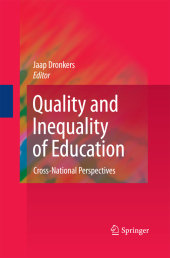 Neuerscheinungen 2014Stand: 2020-02-01 |
Schnellsuche
ISBN/Stichwort/Autor
|
Herderstraße 10
10625 Berlin
Tel.: 030 315 714 16
Fax 030 315 714 14
info@buchspektrum.de |

Jaap Dronkers
Quality and Inequality of Education
Cross-National Perspectives
Herausgegeben von Dronkers, Jaap
2010. 2014. viii, 336 S. 235 mm
Verlag/Jahr: SPRINGER NETHERLANDS; SPRINGER 2014
ISBN: 9400792425 (9400792425)
Neue ISBN: 978-9400792425 (9789400792425)
Preis und Lieferzeit: Bitte klicken
In this book, the authors examine cross-national PISA datasets, the European Social Survey and TIMSS to explore the differences in education and society between Europe and Asia. In addition, the analysis explores economic, legal and historical factors.
This cogent analysis of data on education and society from a variety of sources sets out to provide answers to scientific and policy questions on the quality of education and the way it relates to various forms of inequality in modern societies, particularly in Europe. The authors examine not only the well known cross-national PISA datasets, but also the European Social Survey and TIMSS, going further than many researchers by folding into their analyses economic, legal and historical factors. Most research up to now using the PISA data is restricted to educational research. Interesting as that educational question is, the chapters here use the PISA, and other data, to explore more profoundly the relationship between education and the various forms of inequality in European and other modern societies. The work comes from two different perspectives: one that looks at how the different characteristics of societies, their economies, and their educational systems influence the average educational achievements of specific groups of pupils, such as immigrants, in those societies; and a second, which explores how, and in what degree, the characteristics of schools, educational systems and labour-markets either hardens or softens differences in the educational outcomes of various groups of pupils. With a special feature of the book being its emphasis on comparing Asian and European countries, and with the content free of the political constraints that can often attend studies of these datasets, this book will be an vital resource for educationalists and policy-makers alike.
1. The Gordian Knot between Quality and Inequality of Education. A Cross-National Attempt to Unravelling. Dronkers
2. Institutional arrangements and educational outcomes
2.1. The Influence of Educational Segregation on Educational Achievement, Robert.
2.2. Institutional tracking and achievement growth. Exploring difference-in-differences approach to PIRLS, TIMSS and PISA data Jakubowski
2.3. Educational expansion and social class returns to tertiary qualifications in post-communist countries. Bukodi
3. Migration and educational inequality.
3.1. Educational Gaps between Immigrant and Native Students in Europe: The Role of Grade Retention Park & Sandefur.
3.2. How Do School Regimes Tackle Ethnic Segregation? Some Insights Supported in PISA 2006. Alegre & Ferrer
3.3. The Educational Attainment of Second Generation Immigrants from different Countries of Origin in the EU member-states. Dronkers & Fleischmann
3.4. Talking the same language. How does education in the mother tongue affect the pupils´ scholastic achievement in the parallel school systems? Pasztor
4. Education in Europe & Asia: analogies and differences.
4.1. Intergenerational transmission of income and education in France and Japan. Lefranc, Ojima & Yoshida.
4.2. Japanese and Korean High Schools and Students in Comparative Perspective. Park.
4.3. Family Background, School System and Academic Achievement in Germany and in Japan. Ojima & Below
5. Features of Educational Systems as Factors in the Creation of Unequal Educational Outcomes. Dronkers


